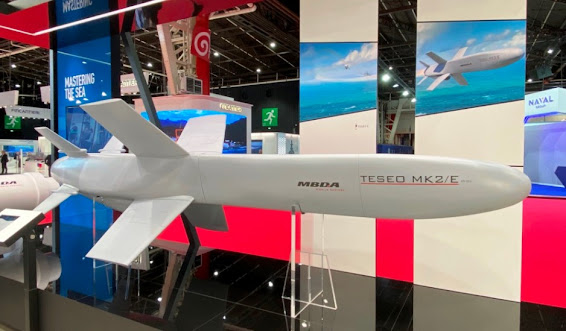Ad Code
Bitcoin
6/Bitcoin/post-list
Weekly
Aircraft
6/Aircraft/post-list
NFT
6/NFT/post-list
MBDA Teseo MK2E 'Evo' – Italian Navy's Next Generation Anti-Ship/Surface Cruise Missile
Richards
7:04 PM
Table of Contents [Show]
Read Also:
The name of the Teseo Otomat anti-ship missile sounds foreign to Indonesian netizens. However, if the FREMM Bargamini class and Maestrale class frigates are acquired by the Indonesian Navy, the name of the anti-ship missile produced by MBDA will be a concern. The reason is that the Teseo Otomat is an anti-ship missile that was originally installed on the two Italian frigates.
Born from the same parent company as Exocet, Teseo Otomat is also presented in several variants. Variant changes as usual show upgrades to capabilities based on the life cycle and the dynamics of existing operational challenges.
The Teseo Otomat currently in service with the Italian Navy is the Teseo MK2A (or also known as Otomat Mk2 Block 4) variant. However, the Teseo MK2A is considered old, because it has been operated by the Italian Navy since 2007 and entered the export market one year later.
Now, the newest variant is the Teseo MK2E or called the Teseo Evo. However, the Teseo MK2E is still in production status and will only be received by the Italian Navy in 2027. And at the SeaFuture 2023 event in La Spezia, Italy, MBDA provided the latest update on the Teseo Evo project.
Quoted from edrmagazine.eu (7/6/2023), MBDA said that it was considering the production of (new missile) Teseo MK2E using some of the components from the current missile (Teseo MK2A Block 4).
The Teseo Mk2E procurement contract was signed in late 2020 and became effective January 21, early 2021, with first deliveries expected in the second half of 2027. The contract covers development, qualification, industrialization, as well as modification of the launch systems to allow them to accommodate both variants, packages Initial logistics are also part of the deal.
The new missile, Teseo MK2E has a launch weight of 700 kg without a booster, this cruise missile has a range twice that of the current one, which is more than 350 km with sea skimming, and will maintain a high subsonic speed.
The terminal maneuverability of the MK2E will be much higher than that of the Mk2A, which is a key feature for countering threats from close air defense weapon systems. The Teseo MK2E is equipped with an AESA radar which will provide increased accuracy and higher resistance to electronic warfare.
The seeker system on the Teseo MK2E, developed by MBDA in collaboration with Leonardo, is currently in the detailed design review phase, with a prototype expected in early 2024.
Another key element of the Teseo MK2E missile is the SATCOM datalink, which is added to the existing line of sight. The two way SATCOM datalink is used to ensure full control of the missile until the last strike phase, with retargeting and aborting capabilities.
Navigation is provided by the GNSS/INS platform, the mission planning system allows giving 4D waypoints, space and time, which makes it possible to carry out saturation attacks launching salvos, missiles that attack targets at the same time from different angles. The sea-skimming system automatically adapts when the missile leaves the maritime environment and starts flying over land at a very low altitude.
The new motor will ensure the propulsion of the Teseo Mk2E, with an axial type booster, while the Mk2A is equipped with two lateral boosters. The Italian Navy does not require a vertical launch capability (VLS), as this means deep modifications to its warships. However MBDA stated that the adoption of the axial booster might open the door for a future vertical launch version.
The Teseo Mk2E passed Preliminary Design Review in March 2023, MBDA is now working hard to reach the Detailed Design Review step. Wind tunnel tests are expected in 2023 to confirm the computational fluid dynamics model.
Five firing campaigns were planned, F0 to validate the initial launch phase, involving thrusters. The F1 will validate the aero-propulsive chain and airframe, the next is the F2 for the seeker, the F3 for validating ground attack capability, and finally the F4 with ship launch which will validate modifications to the ship launch system. The Italian Navy's latest generation of anti-ship missiles will be fully produced at the Italian MBDA factory in La Spezia.
Ratings:
Platform:
Monthly
Ethereum
6/Ethereum/post-list
Warships
6/Warships/post-list
Cryptocurrency
3/Cryptocurrency/post-list
Banking
3/Banking/post-list
Footer Menu Widget
Copyright ©
Escort Wide | Digital Media and Cryptocurrencies











0 Comments